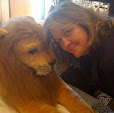Rudyard Kipling is most well-known for his stories and poems extolling the wonders of the British Empire, so I was a bit surprised to find out the story is firmly planted in the American mythos. Published first serially in 1896, Captains Courageous is the story of Harvey Cheyne, son of a railroad tycoon and insufferable brat of 15 who is washed overboard early into a journey from NY to England on an ocean liner with his mother. He is rescued by a fishing boat, the We're Here, whose captain refuses to cut short his fishing season to take him back to NY, even though Harvey assures him that his father will reward him handsomely. Instead, he sets Harvey to work, making him earn his keep, and in a fairly short time, Harvey is relishing the hard work and the camaraderie of his new life.
When he is finally reunited with his parents near the end of the book, his father, in particular, is immensely proud of the man his son has become under the tutelage of Disko Troop, the We're Here's captain. The father acknowledges that he gave his son a life of privilege and so deprived him of the opportunity to make a man of himself through that magic elixir of hard work, courage, and determination that the father experienced himself.
It's good that Captains Courageous is a short novel because the saccharine quality of the story would become too much to swallow after awhile. As it was, I enjoyed it for what it was in the pantheon of Boys Stories, and I particularly enjoyed reading about life in a fishing boat circa 1900 in the Grand Banks of Newfoundland. I also absolutely loved the description of the train trip that Harvey's parents took from San Diego to Boston after they receive word that their son had been rescued. According to Wikipedia, it is a classic of railway literature.
The couple travel in the Cheynes' private rail car, the "Constance", taken from San Diego to Chicago as a special train, hauled by sixteen locomotives in succession. It takes precedence over 177 other trains. "Two and one-half minutes would be allowed for changing engines; three for watering and two for coaling." The "Constance" is attached to the scheduled express "New York Limited" to Buffalo, New York. The car was transferred to the New York Central for the trip across the state to Albany. Switched to the Boston and Albany Railroad, the Cheynes complete the trip to Boston in their private car, with the entire cross-country run taking 87 hours 35 minutes.
I read a little bit about Kipling and discovered that he lived in Vermont for awhile early in his marriage and wrote this novel whilst living there.
I also learned that the book's title comes from the ballad "Mary Ambree", which opens with the line "When captains courageous, whom death could not daunt." Kipling had previously used the same title for an article on businessmen as the new adventurers, published in The Times in 1892.
Here's a sample of the kind of writing that exemplifies Captains Courageous and that made it a fun read for this landlubber who had a print of Winslow Homer's Sailing the Catboat in her room when she was a child.
It thrilled through him when he first felt the keel answer to his hand on the spokes and slide over the long hollows as the foresail scythed back and forth against the blue sky.
 |
| Sailing the Catboat, by Winslow Homer |


I was also surprised to read such an American story by Kipling - at the time, I knew almost nothing about his life. I really enjoy this book (but NOT the film) and re-read it from time to time. I'd love to know more about Harvey's life afterwards - and Dan's!
ReplyDeleteDan was definitely my favorite character. I loved the way he teased Disko, and his positive attitude and zest for life was infectious.
DeleteI wrote a bit about this novel last summer. Frustrating in places; brilliant in others. At that point I had not read Kipling at all, so I had no idea how good he was.
ReplyDeleteThe novel may be more of a parody of Alger. Kipling's boy is rich and has to learn to work. He will get his rewards regardless, so his lesson is that work in and of itself is valuable. A strong shot of Thomas Carlyle runs through Captains Courageous.
I just read your review of CC on your blog: http://wutheringexpectations.blogspot.com/2012/08/the-wrench-and-shloop-of-torn-heads.html
DeleteReally excellent. I felt that CC was sort of like a mini-version of Moby Dick--everything you might ever want to know about cod fishing in the 1900s. Interesting stuff.
I like the idea of CC being a parody of Alger stories. Certainly, it turns the usual formula on its head, but with the same result.
Oh, thanks.
DeleteAnd to anyone not familiar with the long-winded Wuthering Expectations, the post Jane links is just the first of three. All of the juicy Thomas Carlyle stuff is in post #2!
What better way to make sure no one reads that post.
Sad to say I have never read this. I actually did not even know that it was mostly about Americans. As a film buff, surprisingly I have not seen the 1937 film which is very acclaimed.
ReplyDeleteI just read the Wikipedia synopsis of the movie, and the ending is quite different from the book. GRRR...
Delete